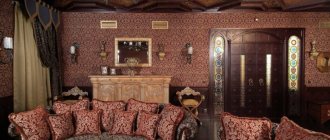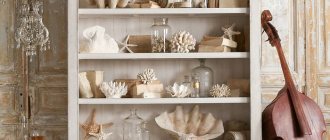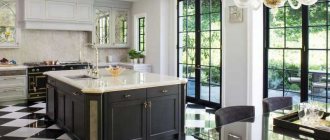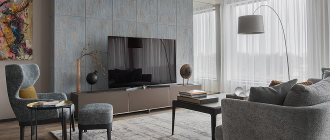Highlights of antique interior design
The era of Ancient Greece and Ancient Rome is famous for its masterpieces of architecture, sculpture, and art. The antique style of interior design is borrowed from the history and culture of these countries.
A little history
Architectural works of antiquity (from 776-476 BC) are role models for masters of later eras. Artists of the ancient world created images that convey the harmony of nature. All the creations of the ancient Greeks and Romans were complete. Compositional construction is an obligatory element of architectural structures, sculptural complexes, and paintings.
The antique style combines the Roman and Greek eras. The Roman style was completely borrowed from Greek culture. Roman and Greek cultures have many similarities, but there are also significant differences. Roman design is more militant, aggressive, with a “taste” of luxury and abundance; Greek elements tend to be closer to nature.
Modern designers do not distinguish between the subtleties of Greek and Roman design and combine them into one concept - antique style.
Modern designers use antique elements to create.
The influence of antiquity did not pass by the Byzantine style, which absorbed many elements of the style of Ancient Greece and Ancient Rome. Byzantine design successfully combines features of antiquity and oriental motifs. In addition to sophistication and sophistication, luxury and pomp characteristic of the East were added.
Characteristic features of the antique style
This style skillfully combines beauty and functionality. The interior elements are beautiful, majestic and practical. The peculiarity of using antique design is that such interior design will not be organic in small areas. Only a spacious room can become a good container for classical antiquity.
In a spacious room it is much easier to embody the basic elements of antiquity
Characteristic features of the antique style in the interior:
- The presence of an arched order cell (triumphal arch).
- Domed ceiling, painted or supplemented with reliefs.
- Decorating walls with frescoes (wall paintings).
- Mosaic floor.
- Decorating the room with floor vases, busts, figurines and majestic statues.
- Use bright colors.
- The use of colonnades and porticoes for room zoning.
- Natural materials (gypsum, wood, natural stone, clay, fabrics).
It should be noted that the grandeur of this style is not associated with an excess of luxury. The richest interiors were decorated with a small number of expensive things. Taste and a sense of proportion always distinguish antique-style interiors, despite the use of gold, inlay, jewelry made of valuable wood, ivory, and precious stones.
Materials for embodying the “antique era” style
When recreating an antique style in the interior, try to use only natural materials or high-quality imitation of them. Use plaster, wood, stone. If your budget allows, then use ivory, marble, and silk for decoration.
Expensive marble arches and columns can be successfully replaced using modern plasterboard or polyurethane. The main thing is that the imitation must be of high quality.
Decorate the walls with decorative plaster in olive, golden or sand tones. Paint in the same tones will also work, but give preference to decorative plaster - it looks more interesting due to its texture and heterogeneity. In addition, it is more pleasant to the touch.
Do not use textiles to decorate the walls - the style does not involve upholstery with fabrics. Natural fabrics can be used for drapes or curtains. If possible, decorate the room with frescoes depicting mythological scenes or stages of ancient Greek history.
Frescoes will be the main element of the interior, defining the atmosphere of the style.
Frescoes
Frescoes in Antique style
Frescoes can be replaced by paintings in gilded frames with similar scenes themes.
Interior decoration in antique style
To make a room in the style of Ancient Greece or Ancient Rome, it is necessary to use the knowledge and skills that the inhabitants of these countries possessed. There are a number of “requirements” that must be met in order to embody the spirit of antiquity in your interior:
- spaciousness and significant footage of premises;
- high ceilings;
- the complexity of the geometric shapes of the rooms, the presence of niches and projections;
- panoramic windows;
- widened openings with double doors.
To recreate the antique style, preliminary preparation is necessary. It is necessary to carefully consider all the interior elements and clearly imagine the layout. The ceiling can be decorated with a painting or painting depicting a military battle, an athletic competition, or a luxurious feast. For the floor, designers use mosaic or marble. The walls are artificially aged and decorated with columns, porticoes, and bas-reliefs. The painting can be located not only on the ceiling, but also on the walls. Glass, crystal, mirror elements in antique design will emphasize the uniqueness of this style. Large mirrors in elegant frames are not uncommon in antique-style rooms. Elegant furniture, the use of upholstery made from natural fabrics, environmentally friendly textiles (linen, teak, satin) characterize the antique style of the premises.
Color solution
Antique style consists of natural materials, without additional coloring. Therefore, initially the interior design in the style of antiquity was muted in color.
In spacious apartments it is much easier to embody the basic elements of antiquity
The interior of that time was dominated by shades of white, brown, beige, and black. Sometimes you could find decorations in blue, olive, or terracotta. Designers of our time prefer to use a contrast of two colors in the interior: black and white, beige and brown, light olive and green. To add saturation, masters of design art have to resort to using several shades of the same color. In any case, no loud or bright colors are suitable for creating an antique spirit in the interior.
Features and characteristics of Antique style
The rigor of the architectural order is the basis for the embodiment of the antique style in the interior. What does the concept of architectural order mean?
In simple words, this is a type of architectural composition in which all elements are subject to a certain stylistic treatment. An architectural order prescribes what the forms of its elements should be, their composition, and relative position. This concept also means that a certain system of proportions must be observed.
Architectural order
So, the antique style in the interior is the observance of a certain architectural order; asymmetry, illogicality, riot of colors or unusual shapes for objects are not allowed here. Everything should be in certain light (ivory), gold, bright blue, yellow tones. Antique bronze will decorate small elements. Terracotta shades and black tones are allowed as an addition.
The antique era in the interior is classic, soft lines, proportionality and antique beauty in every item. Modern interiors in the style of ancient Greece are realized using tapestries, bas-reliefs and paintings with mythological subjects.
An imitation of antique sculptures made from modern materials will complement spacious rooms, creating a unique atmosphere of antiquity and antiquity.
Decoration of ceiling, floor and walls
Compliance with the style largely depends on what materials and colors were used in the finishing of the load-bearing elements.
Ceiling
The entire ceiling can be divided into rectangles or squares. For this purpose, wooden beams with beautiful carvings (caisson structure) are used. The ceilings are decorated with stucco, bas-reliefs, and decorative plaster. The sections are painted or painted in accordance with the chosen color scheme.
You can create such a ceiling using modern materials.
Modern materials make it possible to imitate antique ceiling designs. For this purpose, multi-level tension fabrics are used. They are decorated with polyurethane decor in the form of stucco molding and rosettes. Photo printing on a stretch ceiling will look original, reproducing the beauty of the sky. If you skillfully bring lighting to such a ceiling, the interior will become unusual and memorable.
Floor
The use of natural stone and clay is not always affordable for home owners; these materials can be replaced with more modern and cheaper ones. For example, wooden parquet, natural marble or stone tiles.
Imitation of natural materials or their use are necessary points in creating an antique design
Walls
Increasingly, instead of natural stone, decorative plaster of various shades is used on the walls.
Soft, muted tones will help embody the style of antiquity
It is acceptable to paint on the walls or use frescoes, stucco moldings, bas-reliefs, and borders. The frescoes testify to the campaigns of ancient heroes, battles, illustrate myths or repeat the beauty of nature.
Frescoes are the most common embodiment of antiquity on walls
It is difficult to imagine the antique style without columns and pilasters. If space is required to place columns, then pilasters will fit perfectly into small modern interiors. Vertical ledges will help create the spirit of antiquity without taking up much space.
Furniture
Luxury, wealth or a good imitation of them - this is what characterizes antique style furniture. At the same time, items should be practical and simple. As a rule, furniture is made of valuable wood and inlaid with gold elements. A round table on one leg or a rectangular creation on three/four “supports” surrounded by chairs, armchairs, benches is typical of the antique style. If designers want to accurately reproduce the furniture of those times, then you can find craftsmen who will build real klismos and kline.
Kline and klismos in the interior will emphasize the commitment to antiquity
In the first case, this is furniture of low design with the following elements:
- round back;
- widely spaced curved legs;
- footrest.
Kline is a kind of synthesis of a bed, sofa and klismos. It is interesting that such furniture was used not only for relaxation, but also for eating in a reclining position. The shapes of all furniture items are streamlined and soft. Sharp corners or complex geometric designs will look inorganic in an antique interior. You can find suitable furniture from antique dealers. If this is not possible, you can try to artificially age modern interior items.
Lighting
Panoramic windows are a characteristic feature of the antique style. Large window openings, however, are not able to perform the function of lighting the room to the extent needed in the evening and at night. Therefore, designers provide for the inclusion of many devices in the lighting system: lamps, floor lamps, sconces, chandeliers. It is desirable that the light emanating from these devices in the evening be diffused and soft.
Lamps in the form of candelabra are appropriate in antique design
Artificial fireplaces imitating ancient Greek hearths, wall lamps in the form of torches, candelabra and candles are excellent options for additional lighting of rooms. The main emphasis should still be on the chandelier suspended in the center of the ceiling. The material suitable for the chandelier is bronze or crystal.
A stylized lamp will create an atmosphere of antiquity in the interior
In our time, it is also acceptable to use hidden modern light sources - backlights, spotlights.
Antique interior: characteristic elements of design and decor
An antique interior is an expensive pleasure, since truly majestic things are made only from natural high-quality materials and, as a rule, by hand. The antique style in the interior has not become as widespread as the classic one, although it was the antique style that was taken as its basis.
Despite the inherent love of Ancient Rome for the abundance of sculpture and other decorations, in general the antique interior does not tolerate unnecessary details - it should be simple and elegant.
Antique interior wall decoration
Walls can be either smooth or textured. It will be enough to simply paint them. To do this, use light colors, preferably with the illusion of an internal glow. This way, you can place emphasis on the main decorative elements: carved furniture, paintings or frescoes, tapestries, etc. White, cream, pistachio, opal, light gray, ivory or eggshell colors are suitable.
If the furniture and floor are light or there is a colonnade, naturally white, then the walls should be made more contrasting: green, terracotta or even red.
Antique interior in floor design
Antique style in the interior is when just one floor can become a work of art. It will be very authentic to make it from marble. You can also use ceramic tiles or mahogany parquet. If you choose tiles or marble, we recommend creating a pattern or laying out an ornament. Use calm, contrasting colors, for example, make the floor itself ivory, and the ornament brown or terracotta.
The tapestry on the wall is typical of antiquity, but the carpet on the floor is not. They appeared later. If you cannot imagine your interior without a carpet, then it is better that it has a characteristic ornament.
Antique interior design ceiling
Ceilings are designed to expand space and give a feeling of freedom, so they should be high.
It was in antiquity that caissons appeared, or, as the Greeks called them, kalimmas. These are recesses in the ceiling, most often rectangular or square in shape. Initially, the caissons were designed to relieve the load from the beam floor; later they began to be decorated.
Antique furniture
Only natural noble wood, such as walnut or cherry. Antique furniture often had legs and armrests, backs of chairs and sofas and headboards of beds decorated with carvings and ornaments using gilding or bronze; inlaid with other materials, such as ivory.
A modernized option that will fit perfectly into an antique-style interior is furniture with upholstery with a diamond-shaped screed.
Lighting
In antiquity, natural lighting was used. To do this, you will need large windows during the daytime, and in the evening you can disperse the light sources in the room, for example, highlighting individual sculptures and niches.
Antique interior with decorative elements
The antique interior was most often decorated with sculptures depicting Gods, mythical heroes, and famous personalities. Antique sculpture, like antique architecture in general, combines monumentality and sophistication. The ancient sculpture was made of stone or bronze, darkened or gilded. Architectural solutions such as a colonnade were used, and the passages between rooms were often designed in the form of arches. Moreover, the shape of the arches could be not only classical, but also, for example, pointed. This element of interior design is also very common in oriental style.
Interior decoration also uses mirrors and paintings in wooden or gilded frames and, of course, frescoes and paintings. The theme of frescoes and paintings is usually landscape.
Accents of antique style in modern design
A modern interior in the spirit of antiquity can be emphasized by focusing on the characteristic elements of this style:
- columns and pilasters;
- aged furniture;
- frescoes of antique themes;
- decorative elements.
Floor vases, chests analogous to furniture from antiquity, busts of famous people of that era - all this will make the interior stylish and similar to the homes of the ancient Romans and Greeks.
Interior decoration accepts the use of several or one floor vase of the chosen style
Decorative elements used in antique style:
- Plant or floral imitations - leaves, flowers, stems in the form of intricate designs, inlays or carvings.
- Geometric images (spirals, meanders).
- Mythical characters in the form of sphinxes, mystical lions, unprecedented birds and animals.
- Images of battles (on ceilings, walls, on frescoes).
If the dimensions of the room allow, then majestic statues must be placed in the interior of the antique style; in the case of decorating small rooms, you can use busts depicting famous figures of that era.
The premises for such statues should be quite spacious
Textiles should be rich and natural (linen, hemp, wool). Furniture upholstery and curtains do not tolerate synthetic materials. It is advisable to use a lot of folds and draperies in curtains. Luxurious curtains decorate not only window openings, but also walls; fabrics can also be seen on the ceiling.
When using decorative elements, it is necessary to observe the measure so that the design of the room does not go beyond the chosen style.
Video: examples of antique style in the interior
Features of the interior in antique style
Despite the fact that the word “antique” is translated from Latin as “antiquity,” antique interiors are often found in modern homes. Many trends were created under the influence of this style. Its echoes can be found in classical and Mediterranean interiors, Victorian and Renaissance designs.
Characteristic features of the antique style
Antique style in the interior is, first of all, the integrity of the design, the grace of design and a mandatory sense of proportion. Having absorbed the pomp and grandeur of the Roman style, it remains very laconic thanks to the influence of Greek culture.
Interior design in antique style is based on the principle of the golden ratio. It is based on proportion, which is defined as the division of a whole into a smaller and a larger part, where the larger part relates to the whole in the same way as the smaller to the larger. In fact, this is a 2:3 ratio, in which two-thirds of the room is allocated to the main area, and the remaining one-third serves as an additional area, for example, a relaxation or eating area. Using this principle in design allows you to get a harmonious and holistic room, which is intuitively perceived by a person as an ideal interior.
Aged items are great for styling an antique interior
It is impossible to imagine the antique style without the use of columns. Their arrangement in the interior is based on the principle of an order system, which implies the unity of load-bearing structures and architectural and artistic elements. And this is where its undeniable advantage lies, since uniformity and harmony of design is achieved due to the integrity of all elements present in the interior.
The colonnade and stone figures are distinctive features of the ancient style
Another distinctive feature of the antique style is the abundance of free space. Blind partitions can be successfully replaced with a colonnade or paired columns with arches. But don’t get carried away with supporting elements in a room with modest dimensions. For these purposes, you can leave the standard layout, adding neat half-columns and light stylized ceiling moldings.
Traditional arches in antique style
Despite the fact that the Roman style tends towards luxury and an abundance of details, excessive interior decoration is inappropriate in modern apartments. Otherwise, you risk getting a chaotic parody of antique style and a design overloaded with unnecessary elements.
Color scheme and finishing features in antique style
The antique style design features muted colors. The interior contains shades of brown, beige, ocher, olive, cobalt, and terracotta. Color design can be of two different types: plain and contrasting. To prevent the monochrome interior from looking flat, a large number of volumetric details are used: stucco molding, bas-reliefs, textured columns.
Elegant interior in antique style
In the case of contrasting design, a darker shade can highlight architectural elements and play up niches and bay windows. The color scheme of the antique interior is complemented by reflections of warm metals: gilding and bronze. There are also shades of natural materials in large quantities: wood, marble, granite. Despite the varied color palette, the overall design should look laconic and elegant.
Harmonious interior design in antique style
Restraint must also be exercised during the finishing process. In the antique style, it is not customary to subject the walls to complex or multi-layered designs. Use ordinary light-colored plaster as a coating. If you apply gilding over the main tone with a semi-dry brush, this will add volume to the walls. Textured mixtures are also used for the same purposes.
Using moldings in an antique interior
If you want to create an interior in the spirit of Roman culture, the walls can be decorated with frescoes, stucco molding and borders with ornaments. Decorative elements in the antique style are also used to decorate the ceiling. They should be plain: white or milky. The traditional antique style ceiling is coffered. It is built from ceiling beams, which are placed crosswise, thus obtaining a pattern of cells.
Antique style in the interior with a predominance of Roman style
If the option of a decorated multi-level ceiling is not suitable for you, use plasterboard or stretch fabric. The monochromatic matte finish does not contradict the canons of the antique style and harmoniously combines with the rest of the interior design.
Modern design, stylized as an antique interior
The classic option for finishing the floor in an antique style is tiles or mosaics, complemented by decorative elements and ornaments. If your budget allows, you can use porcelain stoneware or natural wood parquet as flooring.
Antique style in the design of different rooms
Premises for various functional purposes are decorated in antique style.
Living room
There is a huge scope for antique design in this room. It is good if the room being designed is large, with high ceilings. In such an interior you can place frescoes and tapestries without being constrained in size. Large-scale panels will create the atmosphere of the times of the ancient Greeks and Romans.
A modern embodiment of antiquity in the living room interior
The niches house statues of great figures of Ancient Rome and Ancient Greece. The presence of large floor vases will enliven the atmosphere in the living room and help emphasize antiquity. A lamp in the form of a torch looks organic on the walls of the living room; it’s even better if there are sconces in the form of candelabra. When the floor is made of expensive wood or stone, then you should not hide it under carpets, but if modern materials were used for the floor, then it is best to hide them under a beautiful and rich carpet with appropriate patterns. The furniture in the living room should not only be luxurious and rich (made of natural wood with leather upholstery), but also comfortable, because this room is intended for receiving guests and conducting small talk.
Bedroom
You should not install massive columns or sculptures in the interior of the bedroom, even if the room conditions allow this. Rest at night will not be very comfortable surrounded by majestic objects. You can do it much simpler by using only one main item of this style in the bedroom - the bed. A beautiful patterned back, carved decorative elements, and fabric upholstery are the main features of an antique bed in a modern interior.
The main role in the setting is given to the bed with a beautiful headboard
An excellent design solution would be to place the bed in a niche. You can use a built-in alcove, or you can create an artificial recess in the wall yourself. Wallpaper with gilding on the walls is acceptable in a modern antique-style bedroom. Preference in lighting should be given to soft and diffused light coming from lamps in the form of candelabra or candles. Lighting fixtures are located on both sides of the head of the bed. Lots of soft and comfortable textile pillows, beautiful thick curtains will complement the antique design of the bedroom. The main thing is to maintain the color scheme of the entire room without going beyond the style.
Hallway
The central element of the hallway is a mirror. For an antique design, you need to find a mirror in a gilded frame, and place lighting fixtures on either side of it that imitate lit candles or torches. To fully illuminate the hallway, modern methods are also used - fluorescent lamps on the ceiling, decorated with an ornamented portico. Imitation or use of natural stone and marble on the walls will be quite suitable in style to antique design. If it is not possible to use expensive natural materials, you can use Venetian plaster. The floor can be laid with ceramic tiles, plain or with a pattern.
This is what a modern embodiment of an antique style might look like in a hallway
For furniture in the hallway, it is enough to place a low stool on curved legs with gilding or inlay and a chest with decorative carvings. It is advisable to decorate the entrance opening with columns; the use of an arched vault is also permitted.
Bathroom
To embody antiquity in the bathroom, you will need to install a beautiful bathtub on decorative curved legs. If the room allows, then this item can be placed in the center; in this case, a round-shaped bathroom looks great. The bathtub and washbasin can be placed on a kind of pedestal.
Modern plumbing coexists with antique elements
For furniture, a chair with a high back and a fabric ottoman for the feet will be useful. Antique style in the bathroom is incomplete without a massive large mirror with an elegant frame. You can put stylized ceramic tiles on the floor. An image of mythical characters, laid out using modern materials (ceramic granite, tiles), is appropriate on the wall. Color preferences for decorating a bathroom in an antique style are white combined with gold.
Kitchen
The room for preparing and consuming food can also be decorated taking into account the design of ancient times. Beige, olive, and white colors are suitable for introducing an antique style kitchen. The main thing is to try to keep all design elements in the same color. Beautiful crystal chandeliers with modern lamps will not only illuminate the entire kitchen well, but will also help recreate the spirit of antiquity.
The furnishings of the kitchen room are completely designed in the style of antiquity
A large amount of stucco molding and bas-reliefs can be used on the ceiling and walls of the kitchen. Similar elements are added to the facades of kitchen units. It is advisable to implement a coffered ceiling in kitchens with high ceilings, otherwise this design will stand out from the overall style solution and visually reduce the parameters of the kitchen. The floor in the kitchen is designed in contrasting colors to the rest of the decor. An excellent option is a combination of beige and dark brown shades. A mosaic floor covering will not spoil the appearance of an antique-style kitchen. Ceramic tiles imitating marble or natural stone should be placed in the work apron area.
Photo gallery: antique style in modern times
Antique style in the bathroom looks sophisticated and stylish
The grandeur and beauty of the setting do not exclude convenience and functionality
The contrast of colors in the interior looks original
The entrance hall, kitchen, dining room are combined and designed in the spirit of antiquity
Statues are an invariable attribute of ancient design
Antique style in a modern interior will add majesty to the room. The implementation of this design is most suitable for large apartments. You should not oversaturate such an environment with unnecessary decor, because the style solution of antiquity is self-sufficient and beautiful.
- Author: Iya
Rate this article:
- 5
- 4
- 3
- 2
- 1
(0 votes, average: 0 out of 5)
Share with your friends!
Interior decoration of rooms in antique style
The design world has managed to adapt antique style to modern conditions through furniture and decor.
Antique style furniture
The first thing you need to pay attention to when choosing furniture for an antique-style interior is the appearance of the items. All products should look good, high quality and expensive, even if their cost differs significantly from the cost of luxury designer models.
Original interior design in antique style
Antique style furniture is made exclusively from natural wood. It is decorated with carvings, gilding and inlay. Artificial aging and patination of surfaces is allowed in products. In antique stores you can find stylized items that are perfect for interior decoration.
Elegant pieces of furniture in antique style
Another distinctive feature of antique-style furniture is the carved legs of an unusual shape. They are made in the form of animal paws or figures of mythological animals. Such legs were used to decorate not only traditional chairs (klismos) and benches, but also tables. Despite the splendor of the decoration and expensive materials, the furniture does not look massive and has rather simple and streamlined shapes.
Antique style lighting
In an antique-style interior, a lot of attention is paid to natural lighting. This direction is characterized by huge floor-to-ceiling windows with translucent curtains that do not prevent sunlight from entering the room. As for artificial lighting, in most cases floor and wall lamps are used, which, if necessary, are complemented by a chandelier.
Interior decoration in antique style
Since at that time there was no electric lighting, and the rooms were illuminated with torches and lamps, antique-style lighting should be of a warm spectrum, neat and unobtrusive. The main thing is to use stylized lamps in which modern light bulbs will not be noticeable, because they can destroy the authentic atmosphere with their appearance.
Antique style decor items
It is impossible to imagine antique design without ancient Greek amphorae and sculptures. Moreover, just one item is enough for stylization. The main thing is that it looks dignified and elegant. Luxury and chic can be added to the interior with the help of large mirrors in beautiful, expensive frames.
Decorative elements in antique style
A variety of textiles are also used for decoration. These can be tapestries with suitable themes, decorative pillows, elegant curtains. The antique trend does not reject carpets with traditional patterns - meanders.
The antique style is ideal for those who are inspired by the majesty and harmony of ancient Greek or Roman architecture. Using the principles of this direction, you can get an organic and holistic design.











